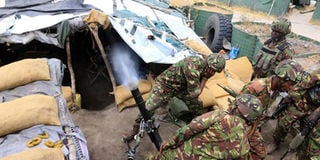Life returns to Kulbiyow camp as survivors take their posts

Kenya Defence Forces soldiers launch a propelled bomb inside their Kulbiyow camp in Somalia on February 6, 2017. The camp was attacked by Al-Shabaab militants two weeks ago. PHOTO | JEFF ANGOTE | NATION MEDIA GROUP
What you need to know:
- Twenty-one of their colleagues died while 44 others sustained injuries and were airlifted to Nairobi for treatment.
- The perimeter of the outer ring is secured with mounds of earth about three meters high.
At the Kulbiyow military camp in Somalia that was attacked by Al-Shabaab terrorists two week ago, one thing sticks out: a huge crater formed by a powerful car bomb explosion.
The blast marked the start of a fierce gun battle that continued for two hours before the attackers retreated and fled.
When the Nation visited the camp on Monday, only a handful of charred motor vehicle parts remained at the scene of the explosion, about 600 metres from the centre of the camp.
Most of the soldiers who fought in that battle were at the camp.
Twenty-one of their colleagues died while 44 others sustained injuries and were airlifted to Nairobi for treatment.
There is a new officer in charge, Major George Osano, who was deployed to replace Major Denis Girenge, who is being treated at Defence Forces Memorial Hospital in Nairobi.
Pointing at the crater, Maj Osano explained: “This is the place where one of the VBIEDs (vehicle-borne improvised explosive devices) exploded. It’s our men who destroyed it before it could reach the camp.
"This big depression shows that the explosion force was downwards because it was hit by a mortar, from above.”
Remnants of the mortar bomb that did the damage are visible on the ground.
“The intention was to drive through and get right into the camp so that when it explodes, there is maximum damage.
"After that, fighters with guns would storm in and face the least resistance,” said Maj Osano.
He explained that the impact of the explosion sent shockwaves to a radius of 200 metres.
On the other side of the vast land, about 800 metres from the centre of the camp, are many spots of blood-drenched ground.
Standing on one spot, Maj Osano explained: “This is where the battle was won. It has been many days, but as you can see, many of their attackers were felled here. You can see how far it is from the camp.”
He added: “We took them out from far away. We are not in the business of gauging how many were killed, all we do is win the war. They could not go past this place and so they decided to leave.”
CHANGING TACTICS
Maj Osano also said: “Most of the attackers are youngsters who have been conscripted by force. We have studied their tactics and so we have also changed [ours] to beat them.
"And we shall keep going on because we know they have discovered VBIEDs will no longer work.”
The camp is dotted with bags filled with sand erected around dugouts that are manned by heavily armed soldiers.
The bags are riddled with bullets that were not able to penetrate through.
The ground is also littered with spent cartridges, the other only sign of the battle nearly two weeks ago.
The bunkers are the defence positions and that is also where the soldiers sleep and keep watch.
This is the area Al-Shabaab militants had planned to reach as they converged on the camp from different directions.
Then there is the outer ring — a big area of land cleared of all bushes and trees so that any invaders are clearly visible from the defence positions.
The perimeter of the outer ring is secured with mounds of earth about three meters high.
This is the area that most of the attackers reached before retreating, and further ahead is where the explosions occurred.
The camp is manned by the C Company of the 15 Kenya Rifles Battalion from Mariakani.




